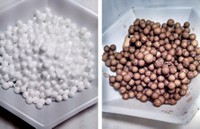Advertisement
Grab your lab coat. Let's get started
Welcome!
Welcome!
Create an account below to get 6 C&EN articles per month, receive newsletters and more - all free.
It seems this is your first time logging in online. Please enter the following information to continue.
As an ACS member you automatically get access to this site. All we need is few more details to create your reading experience.
Not you? Sign in with a different account.
Not you? Sign in with a different account.
ERROR 1
ERROR 1
ERROR 2
ERROR 2
ERROR 2
ERROR 2
ERROR 2
Password and Confirm password must match.
If you have an ACS member number, please enter it here so we can link this account to your membership. (optional)
ERROR 2
ACS values your privacy. By submitting your information, you are gaining access to C&EN and subscribing to our weekly newsletter. We use the information you provide to make your reading experience better, and we will never sell your data to third party members.
Environment
Yeast-Filled Fibers Could Treat Polluted Wastewater
Bioremediation: Yeast embedded in electrospun polymer fibers could break down phenols in the wastewater from olive oil production
by Neil Savage
September 24, 2015

Olive oil may seem like a healthy, natural food. But the process of extracting it creates approximately 2 million tons of wastewater every year in Near East and Mediterranean regions, polluting water supplies and endangering fish. Now a team of scientists is proposing to use yeast embedded in fibers to digest pollutants in the wastewater and produce a usable product such as ethanol (Biomacromolecules 2015, DOI: 10.1021/acs.biomac.5b00970).
Olive oil wastewater lowers the pH level of waterways and pollutes them with phenols, which are toxic to both fish and plant life at relatively low concentrations. The yeast strain Candida tropicalis, present naturally in olive mill wastewater, breaks down phenols. But simply dumping a batch of yeast in polluted wastewater might lead to other environmental consequences, such as affecting soil bacteria, the researchers say, and might also require multiple treatments. So Ilya Letnik, J. Stefan Rokem, and Charles Greenblatt of the Hebrew University of Jerusalem, and colleagues tried encapsulating the yeast inside polymer fibers.
To make the fibers, they first created two polymer solutions: one containing 20% yeast cells by volume in polyvinylpyrrolidone, and another containing a mixture of polyvinylidene fluoride-co-hexafluoropropylene and polyethylene glycol (PEG). They used electrospinning to create the fibers, ejecting a steady stream of the solutions from separate, concentric syringes under high voltage. The resulting fibers consisted of a core containing the yeast cells and an outer, insoluble polymer shell. The presence of PEG in the solution created pores in the outer shell with an average size of 40 nm, large enough to allow water, phenols, and other nutrients to pass through but too small for the yeast cells to escape.
The idea is to create a filter out of the fibers, a sort of “tea bag” that can be dipped into polluted water to allow the yeast to digest phenols, says study coauthor Andreas Greiner, a macromolecular chemist at the University of Bayreuth, in Germany. “When the tea is done—in other words, when the water is clean—we pull it out again.”

Placed in a solution that had an initial phenol concentration of 100 mg/L, the yeast-laced fibers biodegraded 60% of the phenols within 72 hours. Unembedded yeast, by contrast, ate up all the phenols within just 24 hours. That lower efficiency leads Terry C. Hazen, a microbial ecologist at the University of Tennessee, Knoxville, who studies bioremediation, to question whether it’s a more practical method than simply adding free microbes to polluted water. “It’s interesting, and it may be novel,” Hazen says, “but I’m not sure it’s going to be able to compete commercially.” The rate of ethanol production likewise suffered; the free yeast produced approximately 14 g/L of ethanol in 48 hours, whereas over the same time the yeast in fibers produced only 6 g/L.
But Greenblatt says the approach may have other advantages. The yeast stayed alive for three months and even reproduced, so the fibers would be reusable. Also, encapsulating the yeast could potentially avoid new problems that might be created by releasing yeast into the environment. The approach could also be used to embed different fibers with different microbes, creating a series of filters that could remove different pollutants, Greenblatt says.





Join the conversation
Contact the reporter
Submit a Letter to the Editor for publication
Engage with us on Twitter